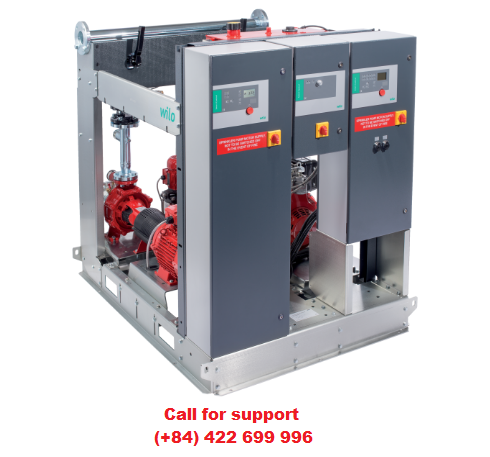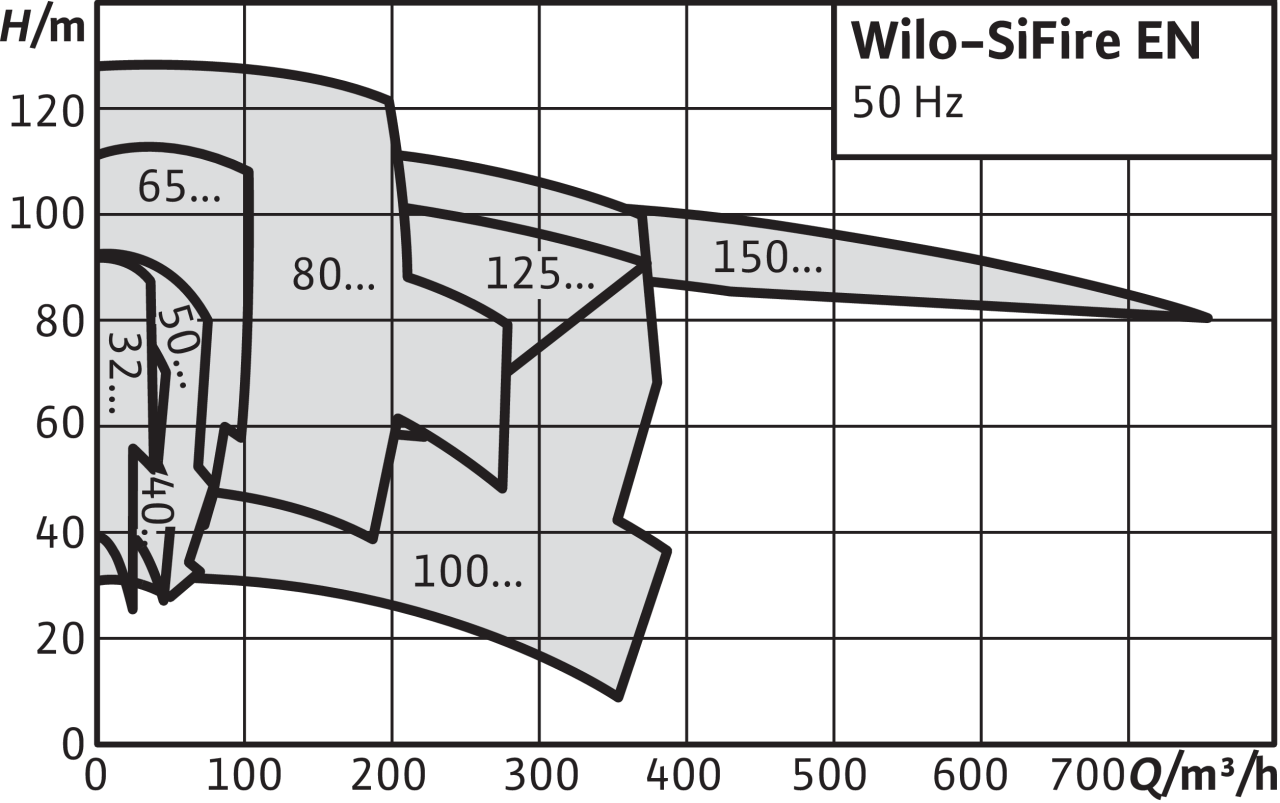

| Example: | Wilo-SiFire EN 40/200-180-7.5/10.5/0.55 EDJ |
| SiFire | Compact pressure boosting system for fire fighting equipment |
| EN | in acc. with EN 12845 |
| 40/200 | Type of main pump |
| 180 | Actual impeller diameter of the main pump |
| 7.5 | Power of the electric motor [kW] |
| 10.5 | Power of the diesel motor [kW] |
| 00:55 | Power of the motor for the jockey pump [kW] |
| EDJ | Configuration |
| E | An electric pump |
| D | A diesel pump |
| J | A jockey pump |
|
Equipment/function
- 1 or 2 pumps with horizontal base frame of series 32-200 to 150-315, with IE2-equivalent standard motor or diesel motor
- With a diaphragm installed directly on the main pump housing to prevent overheating in the event of zero flow - Jockey pump of series MVIL-1 or MVI-1with pressure switch and vertical pressure vessel 20 l, PN16 - One switch cabinet per pump, fixed to a robust support structure. SC Fire model: E for the electric motor and D for the diesel motor, both equipped with Smart Controller, plus J for the jockey pump - Base plate made of electro-galvanised steel with height-adjustable holder for the outlet manifold - Pipework made of steel; painted with epoxy resin. Manifold with flanges - Shutting gate with safety lock on the discharge side of each pump - Non-return valve on the discharge side of each pump - A circuit with dual pressure switch, pressure gauge, non-return valve, valve for the main pump and standby pump for automatic start - Concentric cone on the discharge side of the main and standby pump, for speed limitation according to the parameters specified in EN 12845DN2" connection for the supply tank of the pumps - Pressure measurement on the discharge side - Only for the model with diesel motor: - Vibration damping sleeve on the discharge side of the pump - Vibration damper under the base plate of the pump - Fuel tank with level sensor and sufficient volume for six hours of autonomous operation - 2 or 4 batteries on the base plate and battery charger at the SC Fire switch cabinet - Accessories on request: - Horizontal 500 l supply tank, with float valve and pressure switch for LL-alarm (water shortage) - Flow meter: Kit with eccentric cone on the suction side, complete with check valve with hand lever or handwheel - Vacuum gauge with valve - Valves with electrical contact - Vibration damping sleeve for the manifold - Remote control panel for transmitting level A and level B alarms - Densitometer for the batterySpare parts kit for the diesel motor - Sound absorber (30 dBA) for the diesel motor - Hydraulic heat exchanger for the diesel motor Note on fluids: Approved fluids are generally waters which do not attack the materials used, neither chemically nor mechanically, and do not contain any abrasive or long-fibre constituents. System in accordance with EN 12845 |
|
Description/design
- Base frame: Manufactured from profiles consisting of electro-galvanised steel with brackets for the switch cabinets and the outlet manifold. Special square holes at the bottom for forklift trucks, as well as integrated hooks for lifting slings. Side profiles at the top on each side to enhance the rigidity of the system when moving and lifting.
- Plastic cover at the rear which provides visual access to the valve position and pressure gauge. - Pipework: Complete pipework with flanges made of epoxy resin painted steel, suitable for the connection of all common piping materials; the dimensions of the pipework must correspond to the overall hydraulic performance of the pressure boosting system - Pumps: 1 or 2 pumps with horizontal base frame - EN 733 - with spacer coupling, electric or diesel motor. - Back-pull-out model to ensure the internal parts of the pump are easy to access without having to move the motor or piping. - Valves: The main pumps are fitted with a shut-off valve and non-return valve on the discharge side, both of which are painted with epoxy resin and adapted for a flange connection. - Diaphragm pressure vessel: Diaphragm pressure vessel 20 l/PN16, on the discharge side of the jockey pump, with drain plug. - Tank: The fuel tank is made of metal painted with epoxy resin and is located behind the bracket of the switch cabinet - Sensors and display: 2 pressure switches, 2/16 bar per pump, on the discharge side, for activating the pump start via the SCFire controller and regulator. The discharge side pressure gauge (∅ 63 mm) is located in the middle of the rear panel. - Controller: The system is equipped as standard with a separate switchgear/control device (SC Fire) for the electric or diesel motor and a switchgear/control device for the jockey pump. |
|
Materials For pump with horizontal base plate
- Impellers made of stainless steel AISI 316/ 1.4401 - Pump housing made of grey cast iron EN-GJL-250 - Shaft made of stainless steel AISI 431/ 1.4057 - Wear rings made of bronzeFor the jockey pump - Impellers made of stainless steel AISI 304/ 1.4301 - Pump housing made of grey cast iron EN-GJL-250 (stainless steel AISI304/1.4301 for MVI)Shaft made of stainless steel AISI 304/ 1.4301O-ring seals made of EPDM |
|
Scope of delivery - Factory-mounted, ready-for-installation pressure boosting system, which has been checked for functionality and impermeability
- Packaging - Installation and operating instructions - Required accessories on request |
|
Consulting guide
Inlet pressureThe maximum inlet pressure must be taken into account when designing the system configuration (see Technical data). The maximum permissible inlet pressure is calculated from the maximum operating pressure of the system minus the maximum delivery head of the pump at Q = 0. For sprinkler systems in accordance with EN 12845, the water pressure should not exceed 12 bar. In sprinkler systems with a pronounced slope, in which the difference in height between the highest and lowest sprinkler is more than 45 m, the water pressure can be higher than 12 bar at the pump outlet or in the piping, provided that all of the system components are designed for this pressure level.Installation of the pressure boosting pump under suction conditions.For each main pump, it is necessary to install a supply tank with connection to the discharge pipe above the pump.Volume flowUp to 750 m³/h (208 l/s) system configuration for each main pump.OperationThe operating logic for the fire extinguishing unit is based on the cascade calibration of the pressure switches for starting the pump.The jockey pump is started and stopped automatically by a pressure switch. It is designed in such a way that not only individual sprinklers are supplied with fluid and pressure, but the entire system. This ensures the main pump is prevented from being started and that the system remains pressurised. If a lower pressure value is caused by the demand for water, which is not compensated by the jockey pump, the main and standby pump are started one after the other. The system starts automatically, it can be stopped manually using the switch on the front of the control panel.
|
Nhận xét & Thảo luận